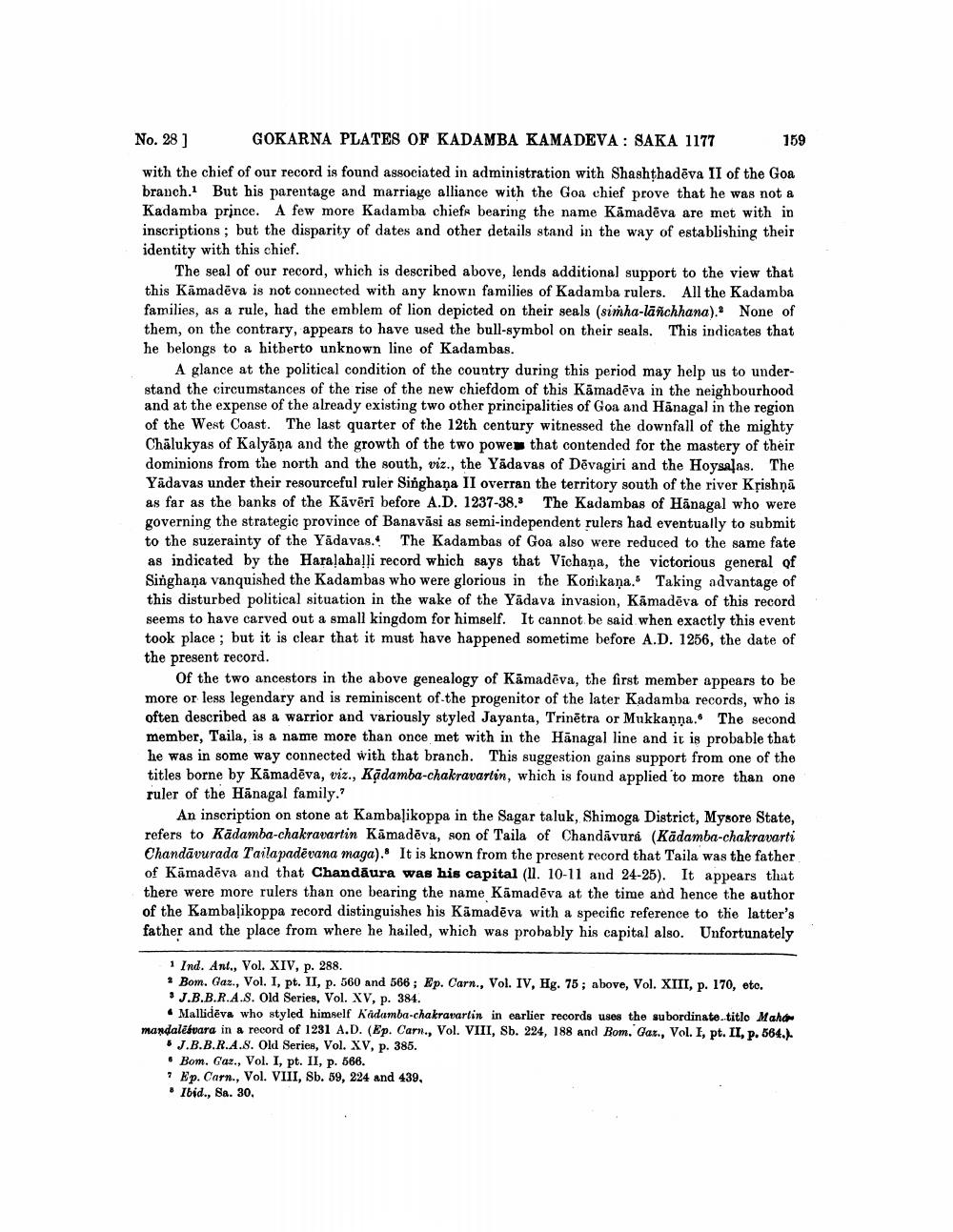________________
No. 28 ]
GOKARNA PLATES OF KADAMBA KAMA DEVA: SAKA 1177
159
with the chief of our record is found associated in administration with Shashthadēva II of the Goa branch. But his parentage and marriage alliance with the Goa chief prove that he was not a Kadamba prince. A few more Kadamba chiefs bearing the name Kämadēva are met with in inscriptions; but the disparity of dates and other details stand in the way of establishing their identity with this chief.
The seal of our record, which is described above, lends additional support to the view that this Kamadēva is not connected with any known families of Kadamba rulers. All the Kadamba families, as a rule, had the emblem of lion depicted on their seals (sinha-lanchhana). None of them, on the contrary, appears to have used the bull-symbol on their seals. This indicates that he belongs to a hitherto unknown line of Kadambas.
A glance at the political condition of the country during this period may help us to understand the circumstances of the rise of the new chiefdom of this Kämadēva in the neighbourhood and at the expense of the already existing two other principalities of Goa and Hänagal in the region of the West Coast. The last quarter of the 12th century witnessed the downfall of the mighty Chalukyas of Kalyāṇa and the growth of the two powes that contended for the mastery of their dominions from the north and the south, viz., the Yadavas of Dēvagiri and the Hoysalas. The Yadavas under their resourceful ruler Singhaņa II overran the territory south of the river Kộishņā as far as the banks of the Kāvēri before A.D. 1237-38.3 The Kadambas of Hänagal who were governing the strategic province of Banavāsi as semi-independent rulers had eventually to submit to the suzerainty of the Yādavas. The Kadambas of Goa also were reduced to the same fate as indicated by the Hara!ahalli record which says that Vichana, the victorious general of Singhana vanquished the Kadambas who were glorious in the Konkana. Taking advantage of this disturbed political situation in the wake of the Yādava invasion, Kamadeva of this record seems to have carved out a small kingdom for himself. It cannot be said when exactly this event took place : but it is clear that it must have happened sometime before A.D. 1256, the date of the present record.
Of the two ancestors in the above genealogy of Kamadeva, the first member appears to be more or less legendary and is reminiscent of the progenitor of the later Kadamba records, who is often described as a warrior and variously styled Jayanta, Trinētra or Mukkanna. The second member, Taila, is a name more than once met with in the Hanagal line and it is probable that he was in some way connected with that branch. This suggestion gains support from one of the titles borne by Kāmadēva, viz., Kadamba-chakravartin, which is found applied to more than one ruler of the Hänagal family.?
An inscription on stone at Kambaļikoppa in the Sagar taluk, Shimoga District, Mysore State, refers to Kādamba-chakravartin Kamadēva, son of Taila of Chandávurá (Kādamba-chakravarti Chandāvurada Tailapadēvana maga).' It is known from the present record that Taila was the father of Kāmadēva and that Chandāura was his capital (11. 10-11 and 24-25). It appears that there were more rulers than one bearing the name Kāmadēva at the time and hence the author of the Kambalikoppa record distinguishes his Kāmadēva with a specific reference to the latter's father and the place from where he hailed, which was probably his capital also. Unfortunately
1 Ind. Ant., Vol. XIV, p. 288. * Bom. Gaz., Vol. I, pt. II, p. 560 and 566; Ep. Carn., Vol. IV, Hg. 75; above, Vol. XIII, p. 170, eto. • J.B.B.R.A.S. Old Series, Vol. XV, p. 384.
Mallidēva who styled himself Kadamba-chakravartin in earlier records uses the subordinate.titlo Mahd mandalībvara in a record of 1231 A.D. (Ep. Carn., Vol. VIII, Sb. 224, 188 and Bom. Gar., Vol. I, pt. II, p. 564.).
. J.B.B.R.A.S. Old Series, Vol. XV, p. 385. • Bom. Gaz., Vol. I, pt. II, p. 566. 7 Ep. Carn., Vol. VIII, Sb. 59, 224 and 439,
Ibid., Sa. 30




